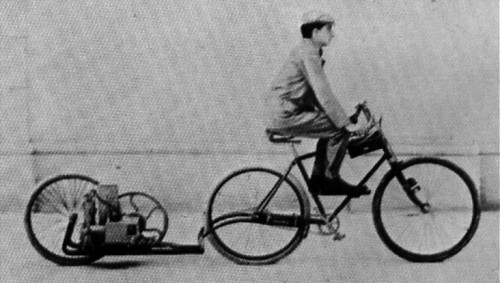Updated: 8 Dec 2010
Petrol tandems added
 
| |
The early history of motorcycle design shows a great deal of variation. This page, in accordance with the philosophy of The Museum of RetroTech, deals only with really unusual motorcycles.
 |
| Left: The pusher-assisted bicycle. Italy 1893.
The engine on the little trolley at the rear appears to be a single-cylinder unit with a big flywheel, pushing a conventional bicycle. The rider has his feet on what appear to be two platforms each side- possibly because the bicycle had no freewheel, so the pedals would have been whizzing round.
No control connections are visible between bicycle and engine, which is rather puzzling.
|
TANDEM MOTORCYCLES
There is nothing unusual about having a pillion rider, but a tandem motorcycle is rather different; no passengers are carried, the man at the back being expected to contribute his share of "light pedal assistance" when necessary. The motor or engine was placed between the two riders.
 |
| Left: The Humber electric tandem: 1897
With four accumulators and an electric motor, plus pedal power from two riders, this machine should have been capable of a fair turn of speed. It was not a one-off. An example was shown at the Stanley Show in November 1897.
These machines were intended for pacing at cycle racing tracks, as indicated by the athletic costume of our intrepid riders. The small capacity of the accumulators made road use impractical.
|
 |
| Left: The Richard-Choubersky petrol tandem: 1899
Nothing is known about this machine except its name. The company also invented and made a form of roller-skate in 1898, and at least one motor-tricycle. Note the De Dion-Bouton engine.
From the French journal La Nature, reprinted by Scientific American Supplement, 9 Dec 1899, p20022
|
 |
| Left: Unknown petrol tandem: 1899
Couret and Boudin were presumably riders rather than the inventors, but that remains uncertain. They are unknown to Google.
The author of the Scientific American Supplement article was unimpressed by the idea of a tandem motor cycle. Talking of their use for training racers, he says: "...such machines do not appear to be any more advantageous than the bicycle for this special application. They are heavier and their speed is no greater by reason of the greater friction that the motor has to overcome; and so we think that the bicycle for one rider possesses more advantages and will, ere long, be master of the road ." Clearly he did not foresee engines powerful enough to pull along a passive pillion rider.
This picture reminds me irresistibly of the works of Edward Gorey.
From the French journal La Nature, reprinted by Scientific American Supplement, 9 Dec 1899, p20022
|

PROPELLOR-DRIVEN MOTORCYCLES
 |
| Left: The Anzani propellor cycle: 1906.
Anzani were a well-known maker of aircraft engines, so putting a tractor propellor on an adapted bicycle was presumably a logical move for them. This machine may have been intended for racing or as a promotion for Anzani engines, as surely no could have thought this was a practical vehicle for use in busy streets...
|
 |
| Left: The Fanbike: 2003.
A more recent propellor-driven cycle, with a shrouded pusher propellor this time. Built by John Wiltbank.
|

THE BÖHMERLAND MOTORCYCLES
 |
| Left: The Böhmerland/Cechie Three-Seater motorcycle: 1935.
The three-seater "long-touring" motorcycle was manufactured by Böhmerland/Cechie in Northern Bohemia at Krásná Lípa. (Now Czechoslovakia) This was just one of their models. The company existed from 1925 to 1939, being brought down by the Second World War. Böhmerland is German for Bohemia; Cechie is a colloquial Czech word for the same area.
This machine was designed by Albin Liebisch, who also designed the OHV 598cc single-cylinder engine. (600ccm is written on the black box by the back wheel) The disc wheels were made of light alloy. There were two cylindrical petrol tanks on either side of the rear wheel, supplementing the usual tank at the front. There was no rear suspension. If you felt the seating was inadequate, you could add a sidecar, so you could carry as many people as in a motorcar.
|
 |
| Left: The Böhmerland/Cechie Four-Seater long-touring motorcycle: 1929.
This is an apparently unique four-seater version of the "long-touring" motorcycle above; it is 10.5 feet long.
598cc does not seem very much capacity to move four people...
|

MULTI-ENGINE MOTORCYCLES
Twin-engine bikes have been built for drag-racing, but this 24-engined bike is unique.
 |
| Left: The "Dolmette" 24-engine motorcycle: 2004.
This 4-meter-long motorcycle was constructed by German comic writer Roetger Feldmann, ("Broesel") and is powered by no less than 24 chain-saw engines coupled together. It is called "Dolmette", as its 24 single-cylinder two-stroke engines are taken from Dolmar PS7900 chain-saws. The result is a total of 1900cc, and 170 HP at 15,000 rpm or 260 km/hr. (161 mph) Whether the bike has actually travelled at that speed is currently unknown. It has a Harley-Davidson 5-speed transmission.
|
 |
| Left: The The "Dolmette" 24-engine motorcycle: 2004.
German comic writer Roetger Feldmann ("Broesel") created a biker character called "Werner", a notorious deadbeat bike-tuner. After his creation had become successful, Broesel decided to construct some of his comic-book inventions in reality for marketing purposes. That's Broesel on the left. His website is at: http://www.werner-broesel.de/
Note the enormous twin exhaust-pipes.
|





















